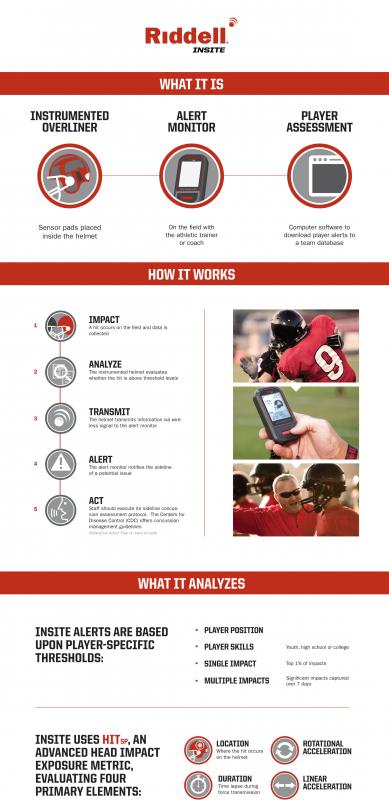Impact Sensors: Riddell InSite Impact Response System - Infographic

RAISE YOUR CONCUSSION AWARENESS
ACTION PLAN
If you suspect that an athlete has a concussion you should take the following four steps:
- Remove the athlete from play. When in doubt, sit them out.
- Ensure that the athlete is evaluated by a health care professional experienced in evaluating for concussions. Do not tgry to judge the severity of the injury yourself.
- Inform the athlete's parents or guardians about the possible concussion and give them the fact sheet on concussions.
- Keep the athlete out of play the day of the injury and until the appropriate health care professional says he is symptom-free and it's OK to return to play. Reference: www.cdc.gov/concussion.
SIGNS OBSERVED BY COACHING STAFF
- Appears dazed or stunned
- Is confused about assignment or position
- Forgets an instruction or play
- Is unsure of score or opponent
- Moves clumsily
- Answers questions slowly
- Loses consciousness (even briefly)
- Shows mood, behavior, or personality changes
- Can't recall events prior to hit or fall
- Can't recall events after hit or fall.
SYMPTOMS REPORTED BY ATHLETE
- Headache or "pressure" in the head
- Nausea or vomiting
- Balance problems or dizziness
- Double or blurry vision
- Sensitivity to light or noise
- Feeling sluggish, hazy, foggy, or groggy
- Concentration or memory problems
- Confusion
- Does not "feel right" or is "feeling down"
All information presented is provided by the Center for Disease Control and Prevention (CDC).
To learn more about the Riddell InSite Impact Response System, click here.
For more about the key features of the Riddell InSite Impact Response System that make it different from other impact response systems, click here.
For a video about Riddell's InSite, click here.
- 9617 reads
- Flag as offensive
- Printer-friendly version








